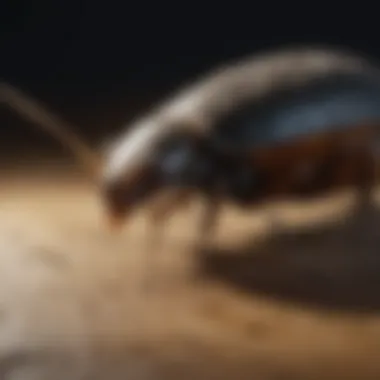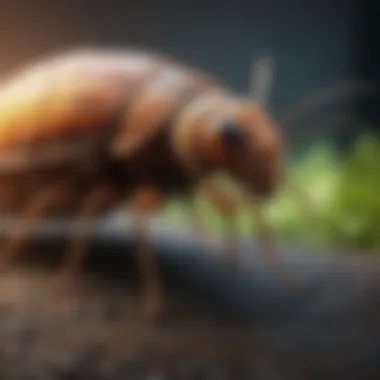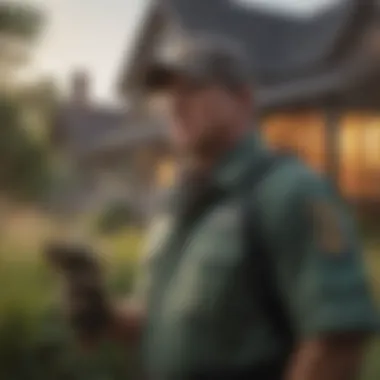Understanding Carolina Pest Management Strategies


Intro
Pest management is a critical topic for homeowners in the Carolinas, where specific environmental conditions and local climates foster unique pest challenges. Understanding which pests are prevalent in this region and how to manage them is essential for maintaining a healthy living space. This guide will provide homeowners with strategies that focus on effective pest identification, prevention, and treatment options. It aims to empower individuals with knowledge and actionable methods to improve their home environments while addressing common misconceptions about pest control.
Pest Identification
Identifying pests effectively is the first step in managing any infestation. In the Carolinas, several common pests can pose threats to homes. Understanding their characteristics and signs of presence can help facilitate prompt action.
Detailed Descriptions of Common Pests
- Termites: These wood-destroying insects are a notable concern. The eastern subterranean termite is prevalent in the region, often causing significant damage before detection.
- Ants: Carolina is home to various ant species, including carpenter ants which can damage wood structures, and fire ants, known for their painful stings.
- Cockroaches: Common in many areas, the American and German cockroaches are particularly problematic in humid environments.
- Mosquitoes: Breeding in stagnant water, these insects are not only nuisances but also potential carriers of diseases.
Signs and Symptoms of Infestations
Being aware of signs indicating pest presence is vital. Look for:
- Droppings: Finding droppings can signal an infestation. For instance, rodent droppings are often found in hidden or dark areas.
- Hollowed Wood: Termite-infested wood may have a hollow sound when tapped.
- Shed Exoskeletons: For insects like cockroaches, the discovery of shed skin can indicate a larger problem.
- Grease Marks: Ants often leave behind greasy or smudgy trails where they frequent.
Prevention Strategies
Proactive measures are essential for keeping pests at bay. Homeowners can adopt several practical prevention strategies.
Home Maintenance Tips for Pest Prevention
- Sealing Entry Points: Inspect and seal cracks and gaps around windows, doors, and the foundation.
- Proper Waste Management: Maintain cleanliness by managing garbage and recycling effectively to avoid attracting pests.
- Landscaping Choices: Keep vegetation well-trimmed and at least a foot away from the house to deter pests.
- Routine Inspections: Regularly check for signs of pests, particularly in areas like basements, attics, and crawl spaces.
Natural Deterrents and Barriers
Utilizing natural methods can be an effective means of pest control. Consider:
- Essential Oils: Oils like peppermint and tea tree can deter ants and spiders.
- Diatomaceous Earth: This natural substance can be used to combat a range of crawling insects without chemical exposure.
- Neem Oil: Effective against many pests, neem oil disrupts feeding and reproduction in insects without harming beneficial organisms.
Treatment Options
When prevention methods fail, treatment becomes necessary. Understanding the options available can help homeowners make informed decisions.
Overview of Chemical vs. Natural Treatments
While chemical treatments can provide immediate relief, natural alternatives often pose fewer risks to health and the environment. Consider the following:
- Chemical Treatments: Products like Raid and Ortho offer a range of solutions for immediate action against various pests. However, they may contain harsh chemicals.
- Natural Treatments: Products derived from plants, such as insecticidal soaps, can be effective against soft-bodied insects without the adverse effects linked to chemicals.
Step-by-Step Guides for DIY Treatments
For those who prefer DIY solutions, here’s a simple approach for tackling infestations:
- Identify Pest: Properly identify the pest and assessment of severity.
- Select Treatment: Choose between a chemical or natural remedy based on your needs and preferences.
- Application: Follow package instructions carefully for chemical treatments or mix ingredient ratios as recommended for home remedies.
- Monitor Results: After treatment, monitor the area for ongoing issues and consider reapplication if necessary.


A considered approach to pest management can save homeowners time, money, and potential health risks from harmful chemicals.
Foreword to Carolina Pests
This section serves as a gateway to understanding the pest challenges faced by residents in Carolina. Highlighting the various pests common to this region lays the groundwork for comprehending why effective management is crucial. Residents must be aware of the significant impact pests can have on their homes and health.
Understanding the pest landscape in Carolina facilitates informed decisions about prevention and control. Knowledge empowers homeowners to recognize signs of infestations early, potentially saving them valuable time and resources. Additionally, it strengthens the case for professional pest control interventions when necessary.
Overview of the Pest Problem in Carolina
Pest problems in Carolina are multifaceted. The region's warm climate and humid conditions create an ideal environment for numerous pests including insects and rodents. Termites, ants, and various roaches often invade homes, leading to structural damage and potential health issues. The increasing urban development also contributes to altering pest habitats, intensifying the conflict between humans and pests.
Residents frequently report issues with these pests, leading to rising concerns about effective control measures. Particularly, termites can cause significant damage, costing homeowners thousands of dollars if left unchecked. Additionally, pests such as cockroaches can pose health risks, as they may carry allergens and pathogens.
Significance of Effective Pest Management
Effective pest management is essential for many reasons. It helps to maintain a safe living environment for families. Pests can introduce diseases and create unhygienic conditions. By understanding effective management strategies, homeowners can mitigate risks associated with infestations.
Furthermore, pest management can have economic benefits. Early detection and treatment of infestations can prevent extensive damage, thereby saving money on repairs. Implementing preventative measures can also reduce the frequency and severity of pest issues.
"An ounce of prevention is worth a pound of cure."
This famous idea resonates strongly in pest management. Preventative actions, such as maintaining cleanliness and sealing entry points, can significantly lower the chances of pest problems.
In summary, familiarity with pests in Carolina and effective pest management strategies are vital for protecting homes and enhancing overall well-being.
Types of Common Pests in Carolina
Understanding the types of common pests in Carolina is essential for homeowners and residents. Knowledge of these pests allows for effective management strategies, leading to reduced damage to property and a more comfortable living environment. In this section, we will explore various pests, their identifying features, behaviors, and the potential challenges they pose. This information will assist in recognition and prevention, which is crucial in maintaining homes free from infestations.
Identification of Termites
Termites are often described as "silent destroyers" due to their ability to chew through wood, flooring, and even wallpaper without immediate detection. Recognizing termite activity early can save thousands in repair costs. Signs include mud tubes on walls, discarded wings, and hollow-sounding wood. Two primary species in Carolina are the Eastern Subterranean Termite and the Formosan Termite. Their colonies can grow large, making swift action necessary upon discovery. Regular inspections and understanding their habits can keep these pests at bay.
Recognizing Ant Species
Ants may seem harmless, but some species can be quite invasive and damaging. In Carolina, the most common are Argentine ants, Carpenter ants, and Fire ants. Argentine ants are known for their ability to form large colonies, while Carpenter ants excavate wood to build their nests, potentially leading to structural problems. Fire ants are aggressive and can deliver painful stings. Identifying these ants involves observing their size, color, and nesting habits. Knowledge about their behavior can help in forming appropriate pest control strategies.
Understanding Rodent Behavior
Rodents, including mice and rats, are notorious for invading homes. Mice are small and typically enter houses in search of food and warmth, while rats are more cautious. Look for droppings, tracks, or gnaw marks as signs of an infestation. Rodent behavior includes building nests, hoarding food, and reproducing rapidly. Effective management includes sealing entry points, maintaining cleanliness, and using traps or baits when needed. Proper understanding of rodent habits can lead to prevention and control of these pests.
Spotting Common Cockroaches
Cockroaches are resilient pests known for their ability to thrive in various conditions. The German cockroach is especially common in Carolina. Signs of infestation include droppings, shed skin, and a musty odor. These pests often invade kitchens and bathrooms, making sanitation critical for prevention. Proper food storage, regular cleaning, and prompt removal of clutter can help mitigate the risk of roaches entering your home.
Detecting Bed Bug Infestations


Bed bugs are small, elusive insects that feed on human blood, often leaving itchy bites on the skin. They can be particularly challenging because they hide in mattresses, furniture, and other tight spaces. Signs of a bed bug infestation include small rust-colored spots on bedding and the presence of bed bug shells. Detection requires careful inspection and vigilance. Integrated pest management is key to controlling infestations, including proper cleaning, heat treatments, and, if necessary, professional extermination services.
Understanding and identifying these common pests is vital for maintaining a safe and healthy home environment.
By recognizing these pests and understanding their behavior, homeowners can implement targeted strategies that reduce the risk of infestations. This section helps establish a solid foundation for effective pest management in Carolina.
Preventative Measures Against Pests
Preventing pest infestations is essential in maintaining a comfortable and healthy living environment. Understanding preventative measures against pests can save homeowners significant trouble and expense in the long run. Effective prevention strategies involve a combination of sanitation, maintenance, and landscaping practices that work together to minimize the risks associated with pest invasions.
Proper Sanitation Practices
Sanitation is foundational in pest prevention. Regular cleaning is not only about aesthetics but also impactful in deterring pests. Here are some key practices homeowners should adopt:
- Regular House Cleaning: Dusting surfaces, vacuuming floors, and cleaning behind appliances remove food particles and debris that attract pests.
- Proper Food Storage: Store food in sealed containers. This prevents access for ants, roaches, and other pests looking for nourishment.
- Waste Management: Dispose of garbage regularly and use trash cans with tight-fitting lids. This limits the food supply pests seek.
Regular sanitation practices not only keep your home clean but also significantly reduce pest-related problems.
Home Maintenance Techniques
Home maintenance is another crucial factor in pest prevention. By identifying and addressing potential entry points and vulnerabilities in your home, you can effectively lower the chances of infestations. Some important techniques include:
- Sealing Cracks and Gaps: Inspect the exterior for openings. Cracks around windows, doors, and foundations can become entry points for pests.
- Repairing Leaks: Pests like rodents and insects are drawn to areas with moisture. Fixing leaks in plumbing and roofs can help minimize these attractions.
- Routine Inspections: Regularly check basements, attics, and crawl spaces for any signs of pests. Early detection can halt potential infestations from spreading.
Landscaping and Pest Control
Landscaping plays a significant role in pest management. The way a home interacts with the surrounding environment can influence pest behavior. Consider the following:
- Proper Plant Selection: Certain plants attract specific insects. Utilize pest-resistant plants, and avoid those that are known to lure pests into your environment.
- Maintaining a Clean Yard: Regularly trim plants and remove debris. Tall grass and overgrown bushes can offer hiding spots for rodents and insects.
- Creating Barriers: Use mulch carefully, as it can harbor pests. Instead, consider using rocks or gravel as a barrier to limit pest access near your home’s foundation.
By focusing on these preventative measures, homeowners in Carolina can create an environment less conducive to pest infestations. Consistent practices not only help in sustaining the integrity of the home but also promote a healthier living space.
Treatment Options for Pest Infestations
Effective pest management requires an understanding of treatment options available to homeowners facing infestations. The methods chosen can significantly impact the success of eradicating pests and ensuring the environment remains safe and comfortable for residents. Pest infestations can lead to property damage and health risks, which is why discussing treatment options becomes essential. Homeowners need to evaluate their specific situations, whether the pests are termites, rodents, or perhaps bed bugs, and consider the best approach tailored to their needs.
Chemical Treatments Overview
Chemical treatments are often the first line of defense against pest infestations. These methods utilize synthetic or natural compounds designed to kill or repel pests. Common chemical treatments include insecticides, rodenticides, and termiticides.
- Insecticides: These target specific insects, disrupting their nervous systems or causing death through various mechanisms.
- Rodenticides: Used primarily for rodent control, these poisons work by affecting the rodent's ability to clot blood or induce other lethal conditions.
- Termiticides: Specialized chemicals injected into the soil or applied to wooden structures to prevent termite infestations or to kill existing colonies.
While chemical treatments can be effective, there are considerations to manage.
- Safety for humans and pets is paramount. Homeowners should ensure that any chemical applied does not pose a risk to family members or animals.
- Environmental impact can also be a concern. Many chemicals can have repercussions on local ecosystems if not used responsibly. Always follow label instructions carefully.
Natural Pest Control Methods


Natural pest control methods have gained popularity due to increasing health and environmental concerns associated with chemical treatments. These methods often involve the use of organic substances and are typically less harmful. Examples include:
- Diatomaceous Earth: This natural powder can kill crawling insects by dehydrating them when they come into contact with it.
- Essential Oils: Oils such as peppermint or tea tree work as repellents for many insects due to their strong scents.
- Biological Control: Introducing natural predators, such as ladybugs for aphid control, can reduce pests without chemicals.
Adopting these methods requires understanding the biology of the pests involved and may take longer to see results compared to chemical treatments.
When to Call Professionals
While DIY treatments have their merits, certain situations call for professional pest control services. Knowing when to seek help can save time, resources, and hassle. Consider contacting a professional when:
- Infestations are severe: If the pest issue appears overwhelming or widespread, it may be time for expert intervention.
- Persistent problems: If DIY methods have failed repeatedly, professionals may provide solutions that work effectively.
- Health risks are present: Certain pests, like rodents and cockroaches, can carry diseases; professional treatment ensures the health of residents remains at the forefront.
Myths and Misconceptions About Pest Control
Understanding the myths and misconceptions about pest control is fundamental for homeowners and housewives. Awareness of these misbeliefs can enhance pest management strategies, ensuring a more efficient response to pest problems. Many times, these common myths lead to ineffective practices or unnecessary panic. This section aims to clarify what is true and what isn't, empowering readers with accurate knowledge.
Common Myths Debunked
- Myth: All pests are dirty and come from unsanitary homes.
This statement is not entirely accurate. Pests can invade homes regardless of cleanliness. Factors such as food availability, warmth, and shelter attract pests like termites and rats. Keeping the home clean is important, but it does not guarantee immunity. - Myth: DIY methods are always enough.
While some DIY pest control methods might be beneficial for minor issues, they are often insufficient for larger infestations. Professional pest control offers targeted treatments that address the root of the problem effectively. - Myth: If you see one pest, there must be many more.
It's easy to think that one visible pest indicates a serious infestation. In some cases, a single pest might be wandering or looking for food. A thorough inspection is necessary to determine the actual level of infestation. - Myth: Chemical treatments are dangerous and ineffective.
Although it is crucial to choose approved pesticides carefully, they can be effective if used correctly. Evidence shows that modern pest control uses safer chemicals that minimize risks to humans and pets.
"Being informed is the first step to effective pest management."
Understanding Pest Behavior
Understanding pest behavior significantly aids in effective control. Each pest species has unique patterns and habits that influence their presence in homes.
- Feeding Habits: Many pests, such as bed bugs and cockroaches, come out primarily at night. Recognizing these patterns helps in applying effective management techniques.
- Reproductive Cycles: Pest populations grow rapidly under favorable conditions. Knowing the reproductive cycles of pests, like termites, can help in timing treatment effectively.
- Habitat Preferences: Pests gravitate towards specific environments. Different pests prefer different conditions, such as moisture or darkness, affecting where they settle. Understanding these preferences allows for better prevention strategies.
By debunking myths and comprehending behaviors, homeowners can adopt more effective pest control measures. This knowledge leads to better prevention, timely treatment, and ultimately, a pest-free home.
Finale and Future Considerations
In considering pest management in Carolina, it is essential to recognize the evolving nature of pest control practices. Regular updates in techniques and strategies are imperative. This is not just about keeping your home pest-free; it is about sustaining a quality of life and ensuring the safety of your family and pets. As environmental conditions shift, so do pest behaviors and populations. Thus, adaptability in pest management strategies is crucial.
Evolving Pest Control Practices
Effective pest management in Carolina is increasingly shaped by innovative practices. Traditional methods are still relevant, but modern techniques offer greater efficacy and safety. For instance, integrated pest management combines multiple strategies instead of relying on a single method. This holistic approach emphasizes prevention and involves residents in maintenance efforts.
Regular monitoring and assessment can significantly enhance management strategies. Homeowners are advised to track pest sightings, conditions that favor infestations, and any changes in the local ecosystem. Furthermore, educating oneself and the family on identifying early signs of infestation can make all the difference.
Emphasis on eco-friendly treatments is another notable trend. Products that minimize harm to beneficial insects and the environment are becoming preferred. This shift not only protects the ecosystem but also reflects a growing awareness of health implications associated with chemical treatments.
The Role of Technology in Pest Management
Technology plays a vital role in modern pest management, particularly in Carolina. Smart technologies are transforming how pest control is approached. There are various applications available that help homeowners identify pests quickly through photo recognition tools. These tools can provide instant information about proper handling and treatment options.
Furthermore, data analytics aids in predicting pest activities based on environmental conditions. This predictive analysis gives homeowners an advanced understanding, allowing them to take preventive actions before issues escalate. For example, humidity and temperature data can signal when to be proactive about specific pests.
"Embracing technology in pest management allows not only for immediate action but also long-term sustainability of practices."
In addition, technology enhances communication between homeowners and pest control professionals. Online consultations and real-time monitoring can facilitate personalized pest management plans. Professional services are also adapting to technology by utilizing drones and digital platforms to assess properties and deploy treatments more efficiently.
In summary, the future of pest management in Carolina hinges on evolving practices and the integration of technology. Homeowners must stay informed and proactive. Understanding these advancements can lead to effective pest control, ultimately safeguarding homes and contributing to the overall wellbeing of the community.



